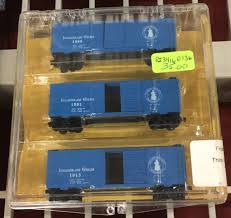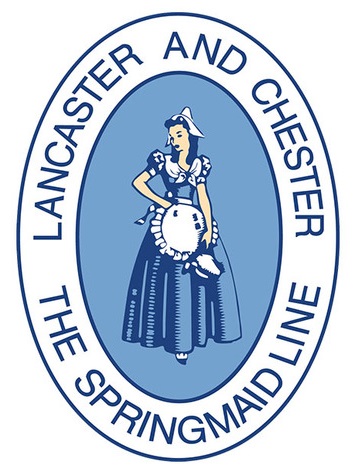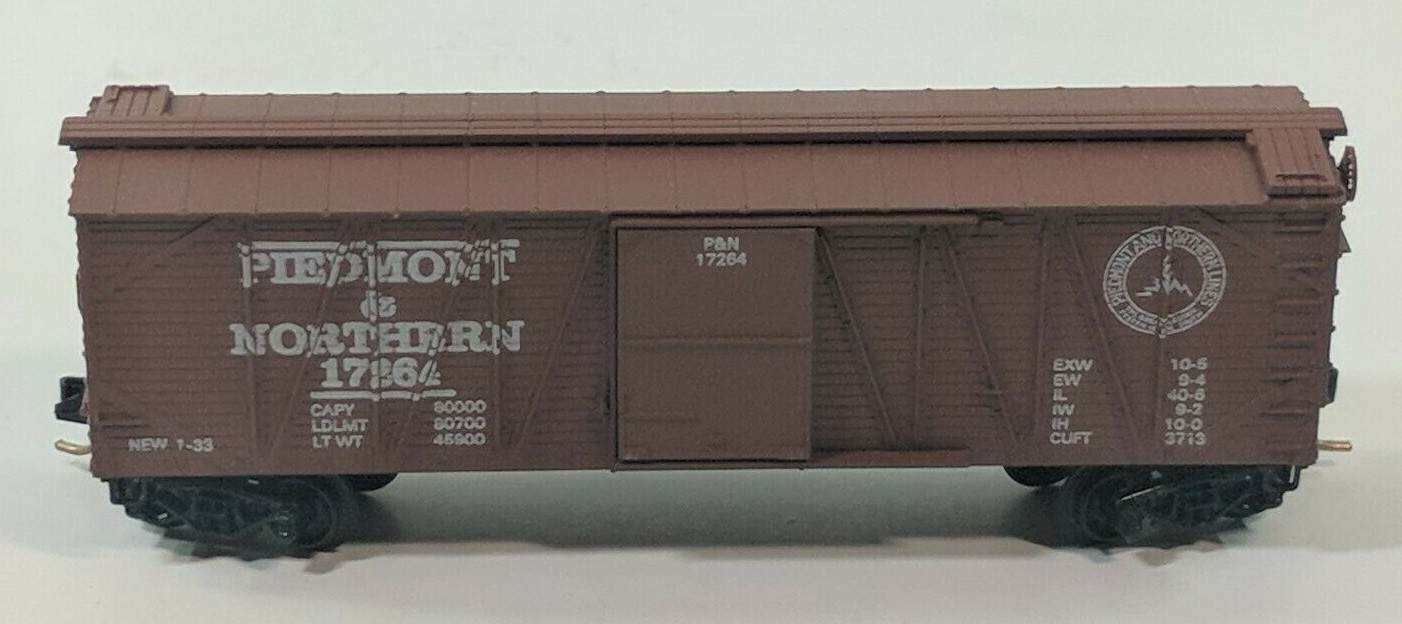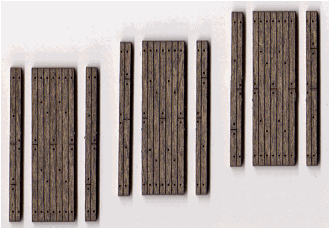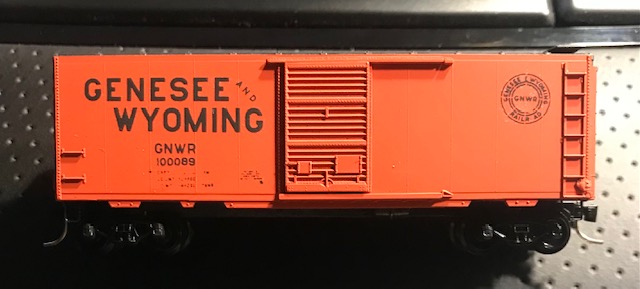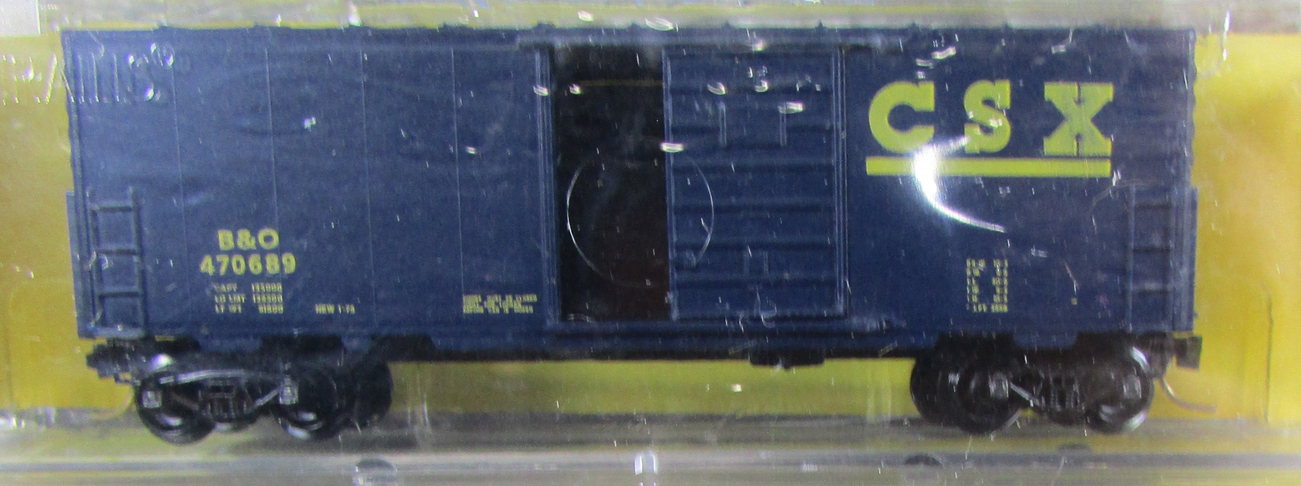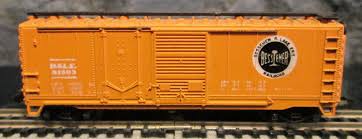Specific Item Information: 3-pack. Road Numbers: 1000, 1001, 1013.
Model Information: This is Micro-Trains first body style. It was introduced in 1972. Its is a model of a Pullman-Standard PS-1 boxcar from circa 1957. Micro-Trains does not market it as a PS-1 so as to allow themselves some latitude so they can use this car to model non-PS prototypes. Hundreds of different releases have used this body style in various paint schemes and road names. They are equipped with 6' sliding doors, either Youngstown (4/5/4 rib pattern) or Superior (7 panels). It is not a model of a "modern" steel boxcar as the length (40 foot) and the roofwalk are more typical of the transition era (1939 - 1957).
In 2019, Micro-Trains started releasing this model with new body-mounted couplers attached to a new underframe.
In 2019, Micro-Trains started releasing this model with new body-mounted couplers attached to a new underframe.
Prototype History: The 40' Boxcar is widely known as one of the most popular freight cars used by railroads as they transitioned from steam to diesel. In particular the Pullman Standard or PS-1 design was one of the most popular and was widely used by North American railroads. These boxcars were built beginning in 1947 and share the same basic design, with certain elements such as door size, door style or roof type varying among the different railroads and production years. When production of these cars ceased in 1963, over 100,000 had been produced.
So just what is a PS-1? Well the simple answer is it is any boxcar built by Pullman Standard from 1947 on. The design changed over the years – sometimes subtly, sometimes for customer request, and sometimes in a larger way. In general, most PS-1’s built from 1947 to 1961 share the same dimensions and basic construction techniques. These cars all had a length of 40′, a height of 10’5″ or 10’6″, welded sides and ends and roof of Pullman’s own design. The greatest variation was in the size and style of doors used. Pullman Standard also offered 50′ and later 60′ boxcars – also with the PS-1 designation.
So just what is a PS-1? Well the simple answer is it is any boxcar built by Pullman Standard from 1947 on. The design changed over the years – sometimes subtly, sometimes for customer request, and sometimes in a larger way. In general, most PS-1’s built from 1947 to 1961 share the same dimensions and basic construction techniques. These cars all had a length of 40′, a height of 10’5″ or 10’6″, welded sides and ends and roof of Pullman’s own design. The greatest variation was in the size and style of doors used. Pullman Standard also offered 50′ and later 60′ boxcars – also with the PS-1 designation.
Road Name History: The L&C began as the Cheraw & Chester in 1873 but the line’s sale on the court house steps to the Spring family in 1896 brought the change in name. The L&C links Lancaster and Chester, North Carolina which is a run of 29 miles. The Spring family owned textile mills along the line.
The early years were pretty rocky. The trestle over the Catawba River burned, followed by a depot a month later. Both were rebuilt. The line was 3’ gauge but by 1902, that was unsustainable and the line was standard gauged. Then in 1913 there was a disastrous wreck of a passenger train on Hooper’s Creek Trestle that killed 5, and wiped out the line’s passenger car fleet and the trestle. That was the end of passenger service for the Lancaster & Chester. Three years later, the bridge over the Catawba River was destroyed again, this time by a flood. The line has 66 curves, some quite sharp. The steepest stretch is Richburg Hill which has a maximum grade of 4.7%.
By the 30’s, the disasters had subsided and the L&C became famous for the use of publicity stunts such as naming 29 vice presidents, one for each mile of line. Gypsy Rose Lee was named Vice President of Unveiling.
The 50’s brought dieselization, first with GE’s and later EMD switchers. All locomotives wear the light blue with white trim and “The Springmaid Line” in the logo (a reference to the Spring’s textile business.)
In recent years, L&C has upgraded their track and bridges, and opened industrial parks along the line. In 2001, L&C bought 31 miles of connecting line from Norfolk Southern running from Lancaster to Kershaw, South Carolina.
This expansion increased traffic dramatically and more locomotives were acquired to augment what had been an all-switcher fleet. As of the end of 2013, the fleet included: three SW900’s, four SW1200’s, two SW1500’s, two GP38-2M’s, two GP38AC’s, and three GP38-2’s.
In 2010, the Spring family sold the L&C to the Gulf & Ohio shortline family. However, it appears for the moment that G&O will preserve the L&C blue paint scheme.
The early years were pretty rocky. The trestle over the Catawba River burned, followed by a depot a month later. Both were rebuilt. The line was 3’ gauge but by 1902, that was unsustainable and the line was standard gauged. Then in 1913 there was a disastrous wreck of a passenger train on Hooper’s Creek Trestle that killed 5, and wiped out the line’s passenger car fleet and the trestle. That was the end of passenger service for the Lancaster & Chester. Three years later, the bridge over the Catawba River was destroyed again, this time by a flood. The line has 66 curves, some quite sharp. The steepest stretch is Richburg Hill which has a maximum grade of 4.7%.
By the 30’s, the disasters had subsided and the L&C became famous for the use of publicity stunts such as naming 29 vice presidents, one for each mile of line. Gypsy Rose Lee was named Vice President of Unveiling.
The 50’s brought dieselization, first with GE’s and later EMD switchers. All locomotives wear the light blue with white trim and “The Springmaid Line” in the logo (a reference to the Spring’s textile business.)
In recent years, L&C has upgraded their track and bridges, and opened industrial parks along the line. In 2001, L&C bought 31 miles of connecting line from Norfolk Southern running from Lancaster to Kershaw, South Carolina.
This expansion increased traffic dramatically and more locomotives were acquired to augment what had been an all-switcher fleet. As of the end of 2013, the fleet included: three SW900’s, four SW1200’s, two SW1500’s, two GP38-2M’s, two GP38AC’s, and three GP38-2’s.
In 2010, the Spring family sold the L&C to the Gulf & Ohio shortline family. However, it appears for the moment that G&O will preserve the L&C blue paint scheme.
Brand/Importer Information: Al's Kustom Train Kars was a model train decorator from 1983 to 2004. They ceased customizing N Scale trains in 2004, but continued business under the same name though unrelated to model trains (on-line shop still available on eBay).
Manufacturer Information:  Micro-Trains Line split off from Kadee Quality Products in 1990. Kadee Quality Products originally got involved in N-Scale by producing a scaled-down version of their successful HO Magne-Matic knuckle coupler system. This coupler was superior to the ubiquitous 'Rapido' style coupler due to two primary factors: superior realistic appearance and the ability to automatically uncouple when stopped over a magnet embedded in a section of track. The success of these couplers in N-Scale quickly translated to the production of trucks, wheels and in 1972 a release of ready-to-run box cars.
Micro-Trains Line split off from Kadee Quality Products in 1990. Kadee Quality Products originally got involved in N-Scale by producing a scaled-down version of their successful HO Magne-Matic knuckle coupler system. This coupler was superior to the ubiquitous 'Rapido' style coupler due to two primary factors: superior realistic appearance and the ability to automatically uncouple when stopped over a magnet embedded in a section of track. The success of these couplers in N-Scale quickly translated to the production of trucks, wheels and in 1972 a release of ready-to-run box cars.
Micro-Trains Line Co. split off from Kadee in 1990 to form a completely independent company. For this reason, products from this company can appear with labels from both enterprises. Due to the nature of production idiosyncrasies and various random factors, the rolling stock from Micro-Trains can have all sorts of interesting variations in both their packaging as well as the products themselves. When acquiring an MTL product it is very important to understand these important production variations that can greatly enhance (or decrease) the value of your purchase.
Please consult our Micro-Trains Collector's Guide

Micro-Trains Line Co. split off from Kadee in 1990 to form a completely independent company. For this reason, products from this company can appear with labels from both enterprises. Due to the nature of production idiosyncrasies and various random factors, the rolling stock from Micro-Trains can have all sorts of interesting variations in both their packaging as well as the products themselves. When acquiring an MTL product it is very important to understand these important production variations that can greatly enhance (or decrease) the value of your purchase.
Please consult our Micro-Trains Collector's Guide
Item created by: gdm on 2017-03-26 20:34:15. Last edited by CNW400 on 2025-02-02 19:35:00
If you see errors or missing data in this entry, please feel free to log in and edit it. Anyone with a Gmail account can log in instantly.
If you see errors or missing data in this entry, please feel free to log in and edit it. Anyone with a Gmail account can log in instantly.


